Maraykes’ top 10 tips for travelling with a manual wheelchair
Sporting Dreams founder Marayke is a qualified journalist and writes professionally about accessible travel for wheelchair users. Link magazine recently featured “Maraykes top 10 tips for travelling with a wheelchair” in their October addition.
As an extra bonus for readers she is expanding on her wheelchair travel tips here on this blog. For Marayke’s expanded version of the story and 7 bonus extra travel tips please scroll down the page. To read the original article on Link magazine please click the image of the article below, it will take you to the Link magazine website.
Bonus accessible tips for Sporting Dreams blog readers
1 Plan ahead: Remember YOU are the expert in your own travel needs, and every hotel and venue will have a different idea of what accessible means. Make a list of what access is essential for you for example roll in shower, door widths, bed height, can you transfer to an ordinary car or do you need to hire a wheelchair van? Do you need a special shower chair or can you make do with a plastic garden chair at the location? Then research everything you can about your destination, and accessibility options for the attractions you wish to visit, transport and accommodation before you leave. The Internet is great but calling for specific details is even better. Be proactive in your planning, remember you know your own needs best and learning to articulate them and plan ahead will ensure a happy holiday.
2 Research everything you can about your destination, and accessibility options for the attractions you want to visit and accommodation. Start by using the internet! Generic tourism sites are good place to start, also search chat websites for people specifically with disabilities ( but be sure to be clear what your needs are specifically versus the experience of other people who you are reading about). Another tip is to look at Google maps in Street view: if your hotel says it is only 200 m walk from the shops or train station, you want to be certain that the 200 m is not directly up a hill or involving stairs. You can see this by zooming in on Google Street view. Contact your accommodation by telephone or email : Looking on the Internet is great- but once you have idea contact the hotel directly and ask specific questions of hotel staff such as are there steps between the hotel and local shops/restaurants. your initial list of nonnegotiable requirements will help you work out which questions to ask. for example I once stayed in a hotel which stated it was accessible, however the carpet was so thick that even as a super muscular Paralympic swimmer I had trouble pushing my wheelchair along the way and had to ask concierge for assistance
3 Decide your priority: perfect access or the experience of a lifetime. Ask yourself how uncomfortable are you prepared to be to have this experience? Sometimes the comfort and access are not both going to be possible, for example to access the pyramids in Egypt I had to climb onto a camel because my wheelchair got bogged. I also climbed over a fence to get out of Pompeii in Italy because it was virtually impossible to push a wheelchair uphill over cobblestones with ruts made by chariots to the exit. sometimes went backpacking we wanted to be spontaneous and stay a few extra nights, or were forced to because of change flights or poor weather changing our plans. If a perfectly accessible hotel could not be found a improvised……. for example we use of office chair with wheels to manoeuvre me into bathrooms where the doorway was too narrow for my wheelchair. I even got pretty good at pulling myself around the room on the chair using this sink etc as leverage.
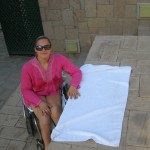
In Egypt’s I was determined to get down beside and swim at the River Nile, despite a very large set of sandstone steps each of which was about the waist height.
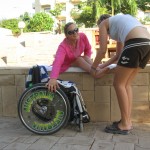
Here you can see me climbing them, with my friend lifting my legs. my friend and my sister then carried my wheelchair up and down the stairs to meet me!
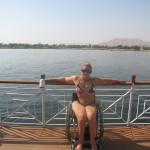
Success in ‘de nile’ after my massive stair climbing efforts. !t was all worthwhile, not to mention the temperature was in the high 40s so getting to water was a high priority.
4Equipment: Consider the destinations you will be visiting and consider whether some aftermarket add-ons to your wheelchair may be of assistance. Also consider the drawbacks of each piece of equipment being how will you transport and carry it and can you manage the weight of the device.
Remember when travelling you may be wishing to walk/wheel much greater distances than you are used to or over different surfaces and there are products designed to help. I recommend trialling all devices well ahead of travel and practising use and transport of them so it is second nature by the time you are on your holiday.
Free wheel: this medium-sized wheel which clamps to your footplate elevating small front casters of the ground, allowing you to traverse grass, cobblestones, gravel and even some sand with ease. It is very lightweight and comes with a perch for storage on the back of your wheelchair.
- zx1: this device clamps onto the axle of a manual wheelchair and turns it into a power wheelchair providing you with the joystick, allowing you to travel greater distances without fatiguing.
- Power assisted wheels: these attached to your manual wheelchair like quick release wheels, and give you a boost of power when you touch the push rim. The drawback is they are very heavy (12 1/2 kg each) and cannot get wet so you will not be able to go outside in the rain.
- Smart Drive: this wheel attaches to your rear axle and as you push forward gives you an extra power boost. It is great for long distances outside, however when it is an outdoor mode you have to do press a button to stop the wheels (which can freak some users out.)
- * please note the author is not endorsed by and receives no benefits from the providers of these devices, and is simply speaking from personal experience and extensive research.
5 Getting Cold feet- and hands
Are you a manual wheelchair user headed for an extra cold climate? Pack gloves- your push rims will be freezing. And while you’re at it some thermals and warm sockswon’t hurt, especially if you have poor circulation in your legs. Likewise if you’re heading somewhere hot- you push rims could be too hot to handle!!! (I experienced this in the outback Queensland towns of Boulia and Cloncurry- stand in the sun too long and it would feel like my hands were burning).

At 45°C in the shade ( even very late in the afternoon) my push rims were burning hot to touch in Boulia, western QLD
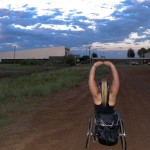
Too hot to handle- hands of the wheelchair push rims its 46° and my hands are burning just touching them in outback Queensland!
6Need an accessible loo on the go? Shopping centres or fast food chains such as McDonald’s are a pretty safe bet. If you are heading to the United Kingdom all public disabled toilets are locked, You need to purchase a special radar Key prior to your departure so you can open the door (a lesson I learned the hard way).
7 Pack a toolkit with everything you need to repair your wheelchair including spare tyre tubes etc- and duct tape (it can get you out of many a sticky situation). Put this in your check in – tools won’t be allowed on board an aircraft.
8 Essential medical items: pack enough essential medical items such as medication, personal care equipment etc in your hand luggage to last you should you have unexpected stopovers or your luggage going missing for a few days.
9 Luggage. When travelling alone (or even with the companion) plan in advance how you will manage your luggage. Most luggage is designed to be operated by people who can walk, for example pull a wheeled suitcase behind them which is not so practical if both your hands occupied pushing a wheelchair.
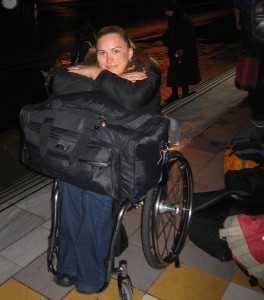
This is how I transport my luggage when travelling solo: a soft duffel bag on my lap, with a strap going behind the back rest of my wheelchair and securing under the bar on the backrest. To ensure it does not slip off I place my handbag and then backpack on the back of the wheelchair. The weight of the duffel bag on the front evens out the weight of my heavy backpack stopping the chair from tipping over backwards. Underneath the chair I have a small zippered bag for essentials like passport wallet and telephone, and have now added a net as well ( great place to stash a jacket in a hurry when exiting at an airport for example)
Tips for managing your baggage
- Straps, bungee cords and soft bags can work a treat. Keep your personal items such as passport/wallet/phone etc easily accessible in your carry on baggage. If you have a heavy backpack behind the wheel chair, you can balance the weight out with a heavy duffel bag on your lap. Tie the bag down with a strap so your hands are free to push. Ensure you can still lean forward enough to go up an incline.
- You can also utilize the space underneath the chair with a pouch, shelf, undercarriage net or a combination of these. I have my handbag on the back of my wheelchair, then use a back-pack as my carry-on, which is on the back of the chair, and then place my main bag on my lap secured with a strap behind the backrest of my chair.
- Never let anyone put your luggage on the floor if you are unable to pick it back up yourself, keep it at lap height e.g. on a table, that we can slide it on and off.
10 Travelling internationally: learn the word for wheelchair/disability access and anything that may be an issue. For example fauteuil roulant means wheelchair in french.
11 Pack the right attitude: Decide your priority. Is it perfect access and relaxation or are you prepared for a bit of discomfort to have the experience of a lifetime. Let this determine the destination of your trip . There is no point going on a holiday you know is not perfectly accessible then spending the entire time complaining about access, yes you may have to go in a different door to everyone else or miss out on certain thing but you will have seen a whole lot more than had you stayed at home.
Besides, the misadventures which happen when travelling with wheelchairs turn out to make some of the best travel stories! Everyone loves to hear about the time my passport was stolen in Italy and I had to crawl up the stairs and onto the floor in a narrow elevator which didn’t fit my wheelchair then roll onto the floor of the Australian Embassy in Milan, only to be greeted by a security guard shouting frantically in Italian until we found someone to translate this situation into English.Just at that moment my sister arrived at the top of the staircase carrying my wheelchair. Why was I laughing so hard? Not only was the situation hilarious all I could see from my vantage point on the floor was a giant framed photograph of then Australian Prime Minister John Howard- only he had a full head of dark hair instead of greying hair and a slightly bald head.
12 If you’re nervous about travelling, try a simple practice trip which is easy perhaps an hour away on the train and work your way up to larger trips. If you are extra nervous or unsure it may help to travel with a companion who knows your needs to help you feel safer and more secure.
13 Transport: Booking a hire car? Request a station wagon with room for your wheelchair in the boot if someone else will be driving you, and remember to ask for hand controls if you will be driving yourself. You could also bring portable hand controls with you. If you need a maxi taxi book one to meet you at the airport (beats standing in line) and get the drivers personal phone number for future bookings. Taking the train? In some countries you need to book more than 24 hours in advance so do your research! Also do your research to ensure that the station you wish to disembark at as wheelchair access, sometimes you may need to go a station further and walk back etc.
14 Health: Think about your health first. Sit on your pressure relieving cushion during long journeys, keep fluids up to avoid urinary tract infections, take care with transfers not to cause any skin breaks, and carry essential medication and medical equipment in your hand luggage when flying so you are not stuck without it should your luggage going missing.
15 Carer and travelling companions
Decide whether it be making the trip by itself or whether you need a carer/ wish to travel with friends. Finding the right travel companion can make or break your trip. I have travelled both with family and friends and on my own, and found benefits to each. When on my own I learn to be very resourceful, and generally found most of the time a stranger was willing to assist if I ever asked for help. Another great source of assistance for simple tasks such as if a towel is placed too high and out of reach is to ask the concierge in your hotel. When travelling with friends or family benefits include that they can drive our hire car without hand controls, can assist me over or small steps or bumps, can step up small steps and read signs except I may not be able to see, and can go into an accessible areas and take photographs to show me so I get a feel for the area. often when travelling with friends and family we do ” drive-by tourism” where I don’t have to get exhausted climbing in and out of my wheelchair because we simply drive the car up close to signs or or natural attractions along the way. my travel companion can jumped out of the car and scout about to give me feedback on if it’s worth getting out, whether the area is accessible or read signs and information etc out to me while I look from the car.
- Travelling with a friend/s or your partner : Think about the kind of assistance you might need on this trip given the access and activity planned and whether you feel comfortable asking these friends for the kind of help which may be required. how much do they know about disability, and will you be comfortable with them seeing you in situations where you may not be as able due to access? Especially if you may need assistance accessing an aeroplane toilet etc. It’s a good idea to discuss these situations prior to departure to be sure everybody is clear of their roles and comfortable. To keep the peace, it is also a good idea to decide before departure what your group will do if a key attraction is not accessible: will the others visit it without you or will you all miss out. Consider how each of you will feel after you return home should you make either decision. You don’t want your friends to regret having travelled halfway around the world and missed seeing something they considered to be the main attraction because you could not get in, or perhaps they would rather not leave you out and simply see another attraction instead. The only way to find out is to talk about it!
- Travelling with a carer If you require a carer, you have two options- travel with your own carer from home or book through an agency at your destination. Research both options and consider what is right for you. Remember your carer will become your travel companion. It will make life easier to be clear before departure who is paying for what, how much leisure and sightseeing time the carer has to themselves each day etc.
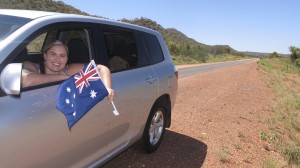
Drive by tourism- mum drove the hire car up close to an ant hills so I could have a look on our way to Boulia where I was to give a speech as an Australia day Ambassador. much easier than getting the wheelchair out of the car and struggling through the gravel.
15 Improvise: If the activity you wish to pursue isn’t obviously accessible, think outside the proverbial square about other ways you could achieve it. For example in Beijing China I wished to take a tour of the ancient Hutong district with my mother on a tuk tuk. The tour involved many stops where you disembarked and visited local homes and destinations so I needed my wheelchair- only problem was that there wasn’t room for my wheelchair on the two-person seat. Solution: we hired a second tuk tuk to follow behind us with my wheelchair! In Egypt we strapped my chair onto a horse and cart when we couldn’t get a taxi home to our hotel from a restaurant, and I rode a camel to see the pyramids when my wheelchair became bogged. On the Greek islands where there was either hills,sand or cobblestones I used a quad bike to get around with my wheelchair tied on the back.

My ‘ Greek islands wheelchair’ a hired quad bike which took me over cobblestone, up hills and even onto the sand at the beach. Notice my wheelchair tied to the back
16 Don’t assume and attraction will be inaccessible: ask
I was astonished to find a stair climber to the parthenon the Acropolis in Greece, which had been installed for the Paralympics. Likewise when I visited the great Wall of China during Beijing Games I expected to be looking at it from the bottom but they had both a stair climber and a team of Chinese army volunteers carrying people in their wheelchairs to the top.
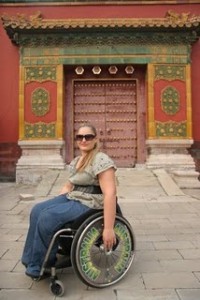
Forbidden city in China, ramps were installed for the first time during the Beijing Paralympic Fames.
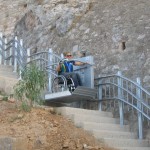
this day climber to the Acropolis- and, incidentally, the most wheelchair accessible public toilet I located in the whole of Athens!
17 Plane travel:
Toilet access on a plane: For first-time travellers this can be the biggest fear. Will I fit in the toilet, what if I don’t get there in time? If you are unable to walk to the toilet the best advice is to plan ahead. For short flights you may be able to reduce your fluid intake and avoid needing to use the bathroom mid flight by going just before boarding, and after landing. For longer flight ask the airline whether an aisle wheelchair will be available on board the flight to access the toilet. However remember the toilet cubicle is tiny and airline staff cannot assist you with dressing, getting on the toilet etc. For peace of mind you may want to consider using a leg bag with an indwelling catheter for the flight or even your entire trip. This negates the need to find an accessible bathroom.
Other tips for travel on planes with a wheelchair
- Consult with your airline about your needs, equipment and specific requirements at the time of booking. Have the dimensions and weight of your wheelchair available as you will need these to book your ticket.
- Check-in for wheelchair users is up to 1 ½ hours early, rather than 30 minutes before the flight.
- Ask the check-in staff to tag your chair to be brought to the gate so that you can get into it directly out of the aircraft.
- Manual wheelchairs: You can remain in your manual wheelchair right up until boarding, or choose to transfer to an airport wheelchair at the check-in counter ( I strongly advocate for using my own wheelchair right up until getting on board the plane as it gives me more independence.
- Power wheelchairs: If you use a power wheelchair you need to transfer to an airline wheelchair at the check-in counter. Follow the airlines directions to disconnect the battery etc for transit.
- Power assisted wheels (such as emotion wheels) cannot be taken on the plane fully assembled. You need to switch to a set of ordinary wheels, check in the power assisted wheels and carry the batteries with you as carry on luggage. Once again consult the airline prior to departure for specific directions.
- When boarding the plane remove everything that can fall off the wheelchair such as side-guards, your seat cushion etc, and pack it in your luggage.
- there are a number of ways you may board the aircraft if you are to walk at all, depending on facilities available at the airport. If the aircraft has access to an aero bridge you will wheel to the door of the plane then transfer onto the aisle wheelchair to reach your seat. If not, such as in small regional airports, you may remain in your aisle wheelchair while being transported in a forklift like contraption down to the tarmac where you transfer to your own wheelchair. On some of my international travels I have even been lifted into the via the catering truck with the in-flight meals beside me!
- If you cannot walk to your seat a narrow aisle chair will be provided . You can transfer yourself or transfer boards and hoists are available.
- When you get to the other end: your chair will either be brought to the gate or come out at the oversized baggage department next to the luggage carousel.
- Ensure your chair is assembled correctly before getting in (e.g. that the wheels haven’t become detached during transport).
- Travelling with an assistance/guide dog? They get their own free seat however you will need to make the appropriate arrangements with the airline well ahead of time.
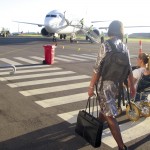
being pushed in an aisle wheelchair to board an aircraft in Mount Isa ( Iowa wheelchairs are made narrower by the fact they don’t have large wheels which you self propel so someone will need to push you.)
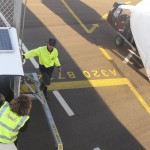
Inside the ‘ forklift ‘ disembarking the aircraft in Mount Isa. These are very narrow. My main advice is that you keep track of the location of your cabin baggage, as most likely airline crew will carry it down the stairs for you and you will need to relocate it on the tarmac.
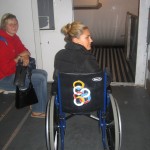
Airline wheelchairs aren’t always the most modern appliances, nor do they allow for great independence…….. so I prefer to keep my own wheelchair until the boarding gate where possible.This one belongs to Olympic airlines in Greece when I’m heading on holidays after the Paralympics ( hence the Olympic rings and why I was so keen to take a photo). we are inside a shipping crate like container on a lifting platform which took me to the aircraft. I then transferred to an aisle chair and my seat.
Over to you:
Have you got any extra tips, or travel accessible stories of your own? Feel free to leave them in the comments section below!


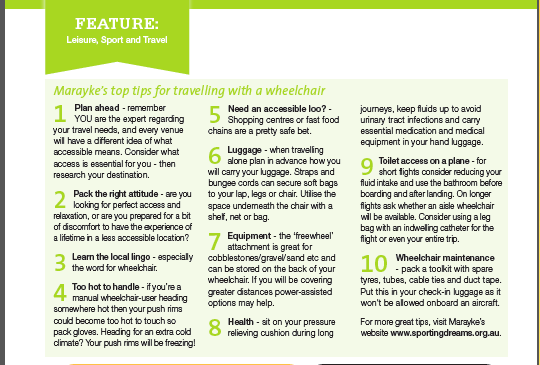
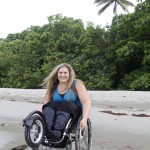
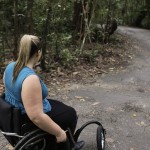

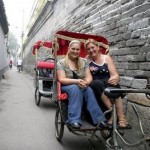


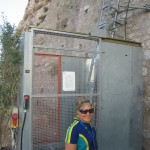

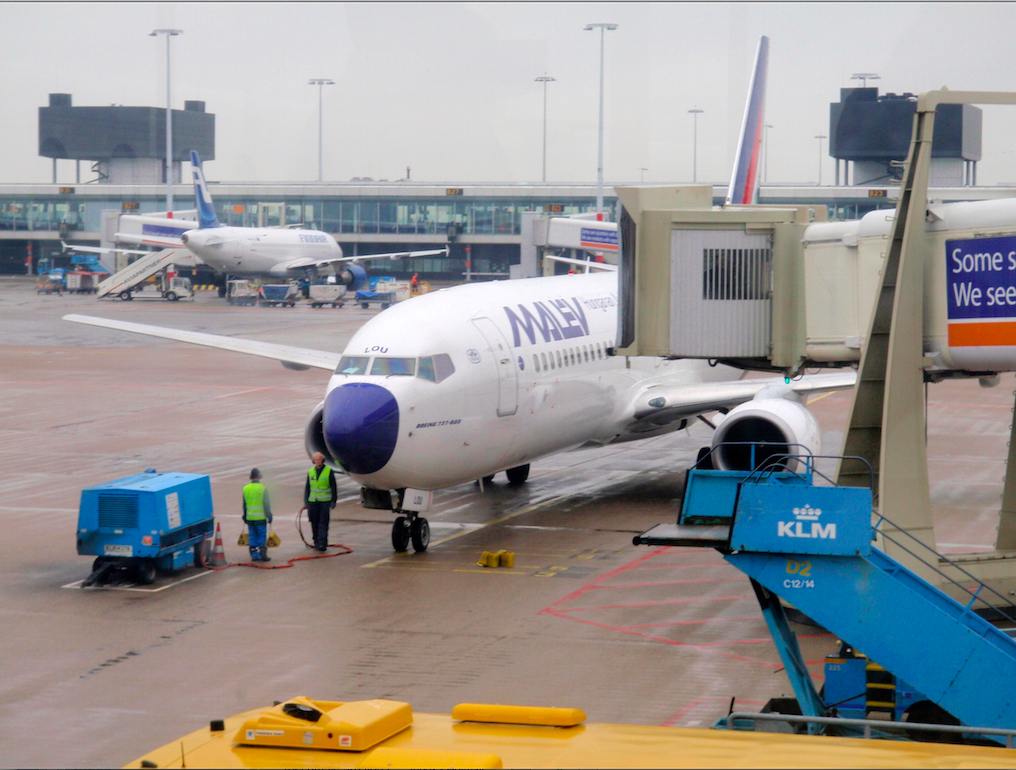
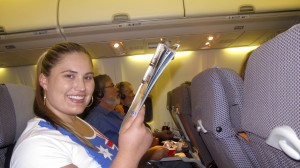
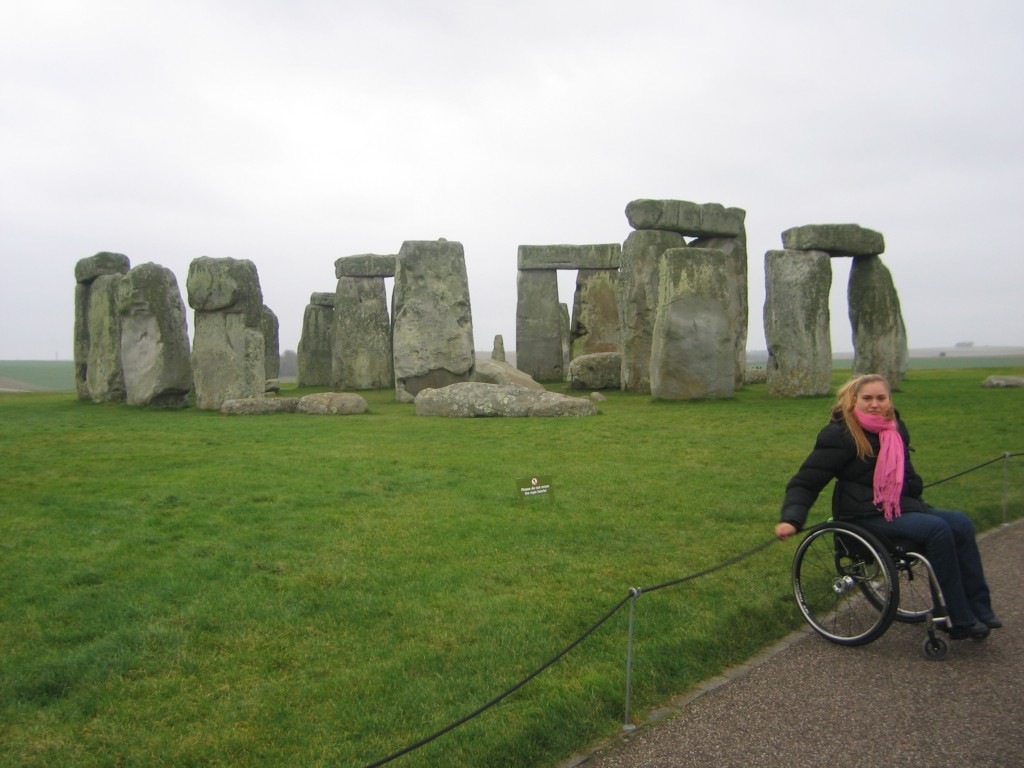
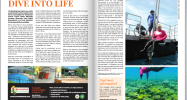
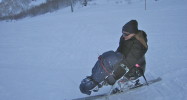
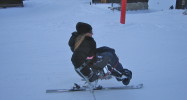
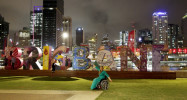

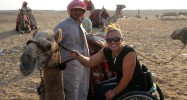





























246693 489057Woh I like your weblog posts, saved to fav! . 599889
774605 115439A genuinely intriguing examine, I could not concur entirely, but you do make some really valid points. 451513
Thank you for generating my individual students have access for your website post….
My family all the time say that I am killing my time here at web, except I know
I am getting know-how every day by reading thes good posts.
If you are looking for a exceptional home where to sleep on vacation in Rome, you would want to check placesofrome.com
The process of creating a vision board is one of the best ways to program the RAS.
“. But people are doing it every day.
I constantly spent my half an hour to read this webpage’s posts
everyday along with a cup of coffee.
Hi would you mind letting me know which webb host you’re using?
I’ve loaded your blog in 3 different web browsers and I must
say this blog looads a lot fasxter then most. Can you recommend a good web hosting provider
at a honest price? Thankk you, I appreciate it!
Very good website you have here but I was curious about
if you knew of any message boards that cover the same topics discussed here?
I’d really love to be a part of group where I can get comments from other experienced
people that share the same interest. If you have any recommendations,
please let me know. Bless you!
Hmm is anyone else experiencing problems with the pictures on this blog loading?
I’m trying to determine if its a problem on my end
or if it’s the blog. Any suggestions would be greatly appreciated.
hi thanks so much for reading the blog. I don’t know specifically, are you talking about travel with a disability sport for athletes with a disability?
A lot can be found via Google or Facebook and depends what information you are looking for then I might be able to provide some more advice.
hotshot hosting
Awesome read. I just passed this onto a buddy who was doing some research on that. He just bought me lunch as I found it for him! Therefore let me rephrase: Thank you for lunch!